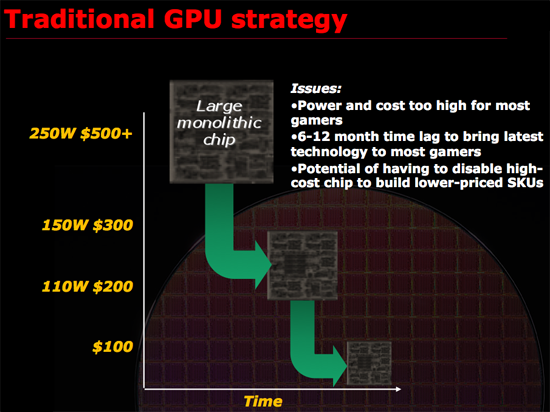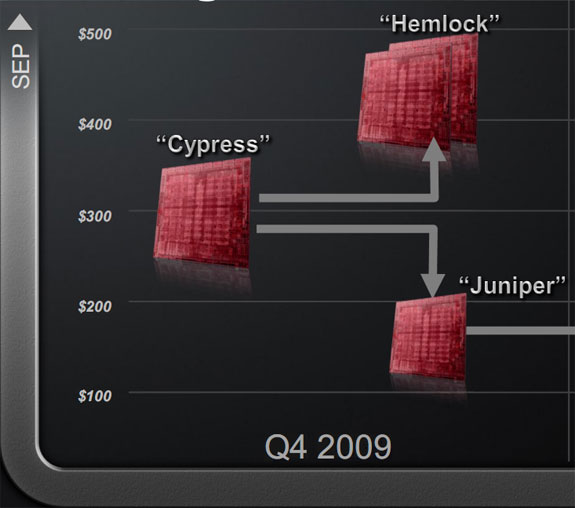The RV870 Story: AMD Showing up to the Fight
by Anand Lal Shimpi on February 14, 2010 12:00 AM EST- Posted in
- GPUs
What Made it All Ok: 4 GPUs in < 6 Months
Through a lot of hard work and sacrifice, even on Carrell’s part, ATI cut the RV870 from as much as 22mm on a side down to roughly 18mm x 18mm. The problem is that RV770 was around 16mm on a side. The RV870 was still too big.
Carrell wanted to cut it down even more, but two things changed his mind. First, in order to build 870 in the space of a 770 ATI would have to cut out much more from the chip than Carrell originally tought. One of the things that would have to go was some of the shader core.
In order to run the GDDR5 memory at the sort of data rates that ATI was targeting for the 5870 the analog PHYs on the chip had to grow considerably. At 16mm on a side ATI would either have to scale back memory bandwidth or eat into the shader core area. Either way we would’ve had a slower chip.
I asked Carrell if 16mm on a side would’ve made the RV870 $100 cheaper at launch, putting it on par with the RV770 launch prices. He said no. I didn’t find out why until much later, but I’ll save that story for another time.
Sacrificing performance to meet the 16mm x 16mm die size targets wasn’t going to happen, but what ultimately convinced Carrell to go with a larger die this time around was something that ATI didn’t get nearly enough praise for: the ability to launch 4 different 40nm DirectX 11 GPUs in less than 6 months.
Remember that Carrell’s beef with building the biggest GPU possible is that it takes too long for the majority of customers to get access to derivatives of that GPU. Look at how long it took G80 or GT200 to scale down. And who knows when we’ll see $150 Fermi/GF100 derivatives.

But ATI Engineering promised two things. First, that Cypress would have a successor called Juniper that would be ready around the same time. Secondly, two more GPUs would follow and the whole stack will be done and out in less than 6 months. ATI came close in 2008 with 3 GPUs in 3 months, but the fourth member of the 4000 series didn’t show up until April of 2009.
It wasn’t an impossible feat. ATI does have concurrent design teams and a lot of engineering resources in India/China. By working on Juniper in tandem with Cypress, assuming there were no show stopping bugs, ATI could exploit efficiencies in two teams effectively working on the same hardware (Juniper was just half a Cypress).
The idea of taking such a huge risk made Carrell uncomfortable. Running two GPU designs in parallel, for the same family of chips, is risky. If everything works out perfectly, you get two chips out at the same time. If it doesn’t, you’ve just tied up two design teams on one product generation. A slip here would give ATI its own Fermi.
What ultimately sold Carrell was the fact that engineering told him that they believed they could pull it off. Carrell believes in people. He believes if you expect the best out of those around you, then that’s what you’ll get. He couldn’t reconcile his beliefs with doubting the schedule engineering was feeding him. Carrell nervously signed off and the Evergreen stack was born.

Cypress and Juniper were delivered nearly at the same time. In fact, Juniper was ready a bit earlier and was sampled to developers months before ATI launched the 5000 series. Cedar and Redwood followed, not to mention a dual-Cypress board that became the Radeon HD 5970. And all of this was done and ready in less than 6 months (the chips themselves were all ready within 4 months).
When the smoke cleared ATI had new DirectX 11 parts at $600, $400, $300, $200, $150, $100 and $60. The Windows 7/DirectX 11 market bulge just got serviced.










132 Comments
View All Comments
devene - Sunday, February 14, 2010 - link
Just like many others, I've been a long time reader and I just couldn't carry on without leaving a comment:This has been an article, just like the RV770 one. It may not reveal many facts but is tremendously insightful and inspiring. Thank you for bringing this deeply hidden information out to the public and to the "fans". Please do everything in your power to continue this trend.
Once again, thank you Anand,
devene
medi01 - Sunday, February 14, 2010 - link
Germans say "lange Rede kurzer Sinn". So many pointless sentences that do not tell anything even remotely interesting.TGressus - Sunday, February 14, 2010 - link
Even the home team could not be sold on Eyefinity...William Gaatjes - Sunday, February 14, 2010 - link
Fantastic article."
First, it massively increased the confidence level of the engineering team. There’s this whole human nature aspect to everything in life, it comes with being human. Lose confidence and execution sucks, but if you are working towards a realistic set of goals then morale and confidence are both high. The side effect is that a passionate engineer will also work to try and beat those goals.
"
Finally, someone accepting and using human nature.
And see it works out...
The fun part is that a requested functionality that is desired but can not make it within the expected timeframe, can still be worked on and can be ready for the next "bulge" in the market. This way you relieve your engineers form stress, you have the time to sort errors and bugs out, you have time to solve unforseen consequences that always happen( people can get sick, a bug in software, machines breaking down) and you have a feature for the market department to market to the consumer for the next iteration of the product. This way you can use the free market to build an in the end perfect device. It is all about balance. If you have to invest to much energy in situation a, you will have less energy for situation b in a certain timeframe. We are bound by laws of nature meaning there is no "perpetuum mobile" in this universe. Nothing comes for free...
aegisofrime - Sunday, February 14, 2010 - link
Anand, you have taken an article that is really technical in nature, and turned it into something entertaining to read and yet informative for non-engineer types. My hats off to you. This is really the right balance of information and readability. If only all the Scientific Papers I have to read were written like this!dukeariochofchaos - Sunday, February 14, 2010 - link
i wonder if you will give fermi the same drama queen touch?i hope so.
Jamahl - Sunday, February 14, 2010 - link
I don't think anyone wants to read nvidia's marketing department tell us how awesome PhysX and CUDA is again tbh.TGressus - Sunday, February 14, 2010 - link
I suspect Fermi will be able to stand on it's technological innovation.RJohnson - Sunday, February 14, 2010 - link
...and it's exorbitant price/die size will exclude mere mortals from owning one.Spoelie - Sunday, February 14, 2010 - link
That depends entirely on the openness of NVIDIA on the subject, historically not one of their strong points.In fact ATi's take on NVIDIA's design process has been more informative than what has come out of NVIDIA itself.
But here's to hoping..